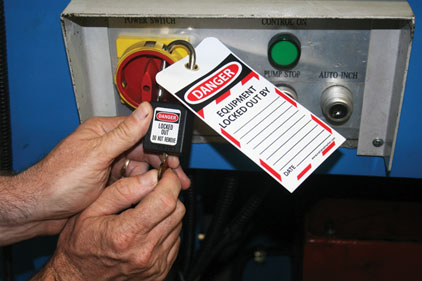If you are an employee, you have at some point taken a shortcut when it comes to safety — especially if you have been performing the same job for years. It is easy to get comfortable with equipment and processes and take for granted the simple steps and precautionary measures that may actually save a life — or maybe you have never had formal training on LOTO (lockout/tagout). If you are an employer, supervisor or manager, you may lack resources to continually monitor LOTO protocols or feel you do not have time for regular training in this area.
OSHA fines for failing to enforce and train workers in LOTO procedures can be in the tens of thousands! An even worse scenario is the death or dismemberment of an employee. The OSHA regulation (29CFR 1910.147) Control of Hazardous Energy (lockout/tagout) requires employers to follow a set of minimum requirements and procedures which have to be documented to ensure there is no release of stored power or that the machinery does not start up when maintenance is being performed. The expectation is that employers should demonstrate a commitment to workplace safety and the health and wellbeing of its employees by providing training on the safe applications, usage and controls for the removal of energy for equipment they operate or conduct maintenance on.
What is hazardous energy?
Hazardous energy is best described as any energy (source) that can cause physical harm to a worker. The most common sources are: electrical, mechanical, chemical, thermal, pneumatic and gravitational. Some people say that all of these are types of kinetic or potential energy being “expressed” in different ways.
Kinetic Energy: “Matter in motion” — The force caused by the movement of an object (examples: machines using gears, belts, levers and pulleys)
Potential Energy: “Energy that is waiting to happen” — The force stored in an object that is not moving (example: spring loaded equipment)
How do I know if lockout/tagout is needed?
Any piece of equipment or machinery in an industrial workforce setting that creates “hazardous energy”, has the potential to cause harm to a worker or may require maintenance, has a need for “LOTO”.
What is the difference between lockout and tagout?
Lockout refers to the use of a padlock to physically “de-energize” and keep power from a machine while maintenance is performed. Tagout refers to “tagging” a machine to make employees aware that a machine is out of operation or lockout cannot be performed. This is not a preferred method, according to OSHA.
Locking a machine that requires maintenance is almost always the best course of action. This method allows the “operator” of the equipment to lock the machine and take possession of the key so the machine is not accidently activated.
Tags should only be used when a lock cannot be used or if the employer can prove that an employee is fully protected and is just as safe as if they were using a lockout device. Train employees in the limitations of tagout programs. Please note there is a strict criterion that must be followed in order to make this determination. (See Paragraph c (3) of the 1910.147 standard.)
Where do we start?
Establish a corporate-wide Energy Control program (1910.147 (c),(1) that is strictly enforced and consists of:
Energy control procedures (1910.147 (c),(4)
Develop procedures that are well documented, communicated and utilized by all supervisors and employees who operate or maintain equipment
Protective Materials & Hardware (1910.147 (c),(5)
All protective devices and hardware are required to be singularly identifiable, be the only device used for controlling energy and not be used for other purposes. They must meet additional requirements of durability, standardization, be substantial and identifiable.
Periodic Inspection (1910.147 (c),(6)
Employers are required to conduct an inspection of these energy control procedures — at least annually.
Training & Communication (1910.147 (c),(7)
It is the responsibility of the employer to provide training (and re-training) so that employees have the skills required to operate machinery safely.
Develop a set of procedures on how to prepare the machinery for shut down, the number and type of lockout/tagout devices needed and where they will be used.
Prior to restoring the energy (power) to a machine, procedures for the release of lockout/tagout should be performed (1910.147 (e).
(Please refer directly to the standard for more specific requirements related to the above program & procedures. Also, additional requirements may apply — see 1910.147 (f))
Provide employees with daily reminders and periodic training on LOTO procedures with training programs, videos and posters. Communicate the regulations and impose stiff penalties when procedures are not followed.

